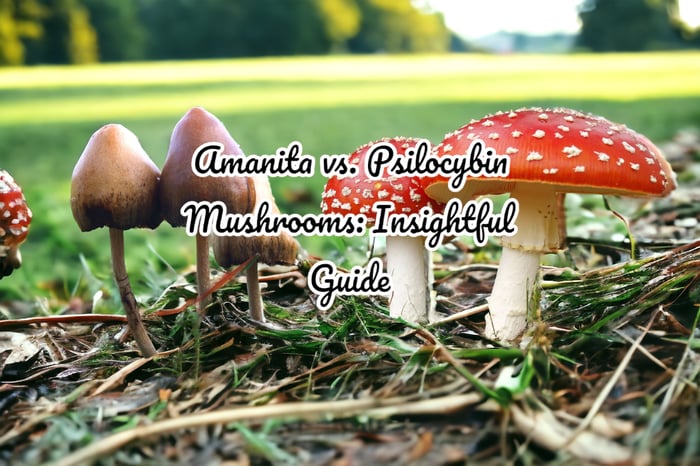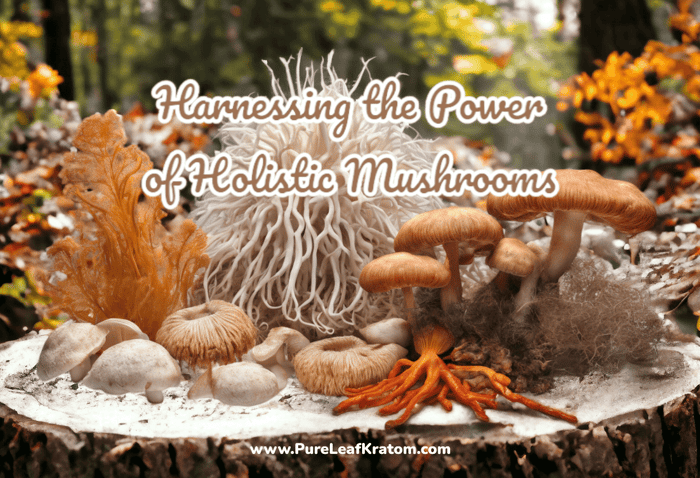
Decoding the Differences: An Insightful Guide to Amanita Mushrooms and Psilocybin Mushrooms
Amanita Mushrooms
Amanita mushrooms, part of the Amanitaceae family, exhibit a characteristic umbrella-shaped cap, with numerous species known for their vibrant colors. Toxic varieties of Amanita mushrooms, like the Amanita phalloides or 'death cap', can be lethal if consumed, while others like the Amanita muscaria, known for its striking red cap, are hallucinogenic.
Psilocybin Mushrooms
Psilocybin mushrooms, colloquially known as 'magic mushrooms' or 'shrooms', are infamous for their psychedelic properties. The active compound, psilocybin, triggers alterations in thought, perception, and mood, and has been the subject of increasing medical research in recent years.
Common Misconceptions about Amanita and Psilocybin Mushrooms
A number of misconceptions revolve around these mushrooms, from their toxicity to their hallucinogenic properties.
Myth: Drinking milk with Amanita reduces toxicity
One common belief is that consuming milk with toxic varieties of Amanita mushrooms can reduce their harmful effects. In reality, no scientific evidence supports this. The toxins in the mushrooms, such as amatoxins in the deadly 'death cap', are not rendered harmless by milk, and can still cause severe liver damage or death.
Myth: All psychedelic mushrooms are psilocybin
Another misconception is that all psychedelic mushrooms contain psilocybin. In fact, there are many diverse species of hallucinogenic mushrooms, only some of which contain psilocybin. Others, like the Amanita muscaria, contain different psychoactive compounds.
Physical Differences between Amanita and Psilocybin
There are numerous dissimilarities between Amanita and Psilocybin mushrooms regarding their habitat, appearance, growth cycles, and nutritional factors. These variations crucially contribute to the identification and understanding of both types of fungi.
Habitat conditions and locations
Geographical regions where Amanita grows
Amanita mushrooms are found predominantly in temperate and boreal regions across the world. They commonly form symbiotic, mycorrhizal relationships with the roots of certain host trees. This preferential relationship brings about their wider presence in rustling forest environments throughout North America, Europe, and parts of Asia, as per the Mushroom Collecting study.
Geographical regions where Psilocybin grows
In contrast, Psilocybin mushrooms have a more global spread, growing in nearly all climates and conditions, so long as mild temperatures, damp conditions, and organic decaying materials are present. This diverse distribution makes them flush in areas like the Pacific Northwest, British Columbia, Central and South America, Australia, and Europe, according to data from Double-Blind.
Appearance
Key features of Amanita
The easily recognizable form of Amanita mushrooms typically includes an umbrella-shaped pileus or the cap, and a slender, somewhat fibre-filled stipe or stem. A ring or annulus is often present around the upper stem, while a unique "volva" or bulbous base is a distinguishing characteristic. Many Amanita species also display gills beneath their caps, as highlighted by Mushroom Collecting.
Key features of Psilocybin
Psilocybin mushrooms, on the other hand, possess a darker and smaller cap, exhibiting various shades from golden brown to dark grey. Unlike Amanitas, the cap's surface sports remnants of a common veil (that breaks as the mushroom grows, leaving behind a ring-like structure on the stem) and bruises blue when handled or injured, as described in Shroomery.
Growth cycles
Seasonality of Amanita
Most Amanita species tend to emerge during the warm summer and early fall seasons. They thrive when the environment mirrors the damp, cool characteristics of the forests they inhabit.
Seasonality of Psilocybin
Contrarily, Psilocybin mushrooms have a more broad growing season, though many species favor fall, winter, and early spring. Predominantly, they flourish after rains in humid environments, as noted in an overview by Shroomery.
Nutritional factors
Nutritional makeup of Amanita
While precise nutritional details are hard to come by, ingestion of many species of Amanita mushrooms is not advised. This is due to the presence of lethal toxins in certain species, such as the Death Cap (Amanita phalloides), and the equally hazardous Destroying Angel (Amanita virosa).
Nutritional makeup of Psilocybin
Psilocybin mushrooms, too, should be consumed with caution due to their hallucinogenic properties. Their active compound, psilocybin, is converted to psilocin inside the body, impacting serotonin receptors in the brain and inducing various perceptual changes.
Chemical Differences
A careful examination of the unique chemical compositions of Amanita and Psilocybin mushrooms reveals significant differences in their properties and effects. This divergence is primarily due to the unique key compounds found in each of the two mushroom types.
Key Chemical Compounds in Amanita
Amanita mushrooms have several active compounds, with muscimol and ibotenic acid being the most salient. Muscimol is primarily responsible for the psychoactive properties of Amanita mushrooms. Unlike other compounds, muscimol interacts directly with certain brain receptors, resulting in a range of neuropsychological effects.
Ibotenic acid, on the other hand, is a potent neurotoxin. The human body can convert ibotenic acid to muscimol, hence contributing to the mushrooms' psychoactive effects. Other active compounds such as muscazone and muscarine are present in smaller amounts and contribute less significantly to the overall experience.
Key Chemical Compounds in Psilocybin
Psilocybin mushrooms derive their psychoactive properties from psilocybin and psilocin. Psilocybin is a prodrug - a substance that the human body converts into a drug, in this case psilocin. Psilocin directly interacts with serotonin receptors in the brain, leading to a variety of psychological effects.
Psilocybin mushrooms also contain smaller amounts of other compounds, such as baeocystin and norbaeocystin. However, their precise contributions to the overall psychoactive effect are less well-studied compared to psilocybin and psilocin.
Differentiating the Two Based on their Chemical Compounds
Although both types of mushrooms induce psychoactive effects, the compounds involved and their specific impacts on the brain differ greatly.
Muscimol, the principal active compound in Amanita mushrooms, primarily interacts with GABA receptors in the brain. GABA is a neurotransmitter that inhibits certain brain functions, leading to a calming effect. Therefore, consumption of Amanita mushrooms typically results in a sedative-hypnotic state.
In contrast, psilocybin and psilocin, the key active compounds in psilocybin mushrooms, bind to serotonin receptors. This interaction generally induces significant alterations in thought processes, mood, and perception, causing a psychedelic experience.
Another significant distinction rests in the toxicity levels of the compounds. Amanita mushrooms' ibotenic acid is a neurotoxin, potentially leading to harmful effects, whereas, psilocybin mushrooms' main compounds display a lower toxicity profile.
The different nature and interaction of the key compounds in Amanita and Psilocybin mushrooms contribute not only to their disparate psychoactive effects but also to a range of potential health implications and risk factors associated with their consumption.
Effects on the Human Body
Both Amanita and Psilocybin mushrooms interact in unique ways with the human body, causing a range of physical and mental effects. These effects play a significant role in their use and classification. Understanding these effects is essential for safe consumption and handling of these mushrooms.
Physical Effects Induced by Amanita
Amanita mushrooms, particularly Amanita Muscaria and Amanita Pantherina species, contain ibotenic acid and muscimol which interact directly with the nervous system. Upon ingestion, these substances stimulate the central nervous system causing a series of physical manifestations. These include increased salivation, sweating, and tear flow. It can also cause gastrointestinal symptoms, including nausea, vomiting, and diarrhea.source
Physical Effects Induced by Psilocybin
Compared with Amanita, Psilocybin mushrooms, also known as "magic mushrooms", have a different set of effects. Psilocybin, the active compound in these mushrooms, is a potent serotonin receptor agonist. Physical effects may include pupil dilation, changes in heart rate and blood pressure, nausea, jitteriness, and irregular motor functions. High doses may also result in a state of physical euphoria.source
Mental Effects Induced by Amanita
On the mental front, consumption of Amanita mushrooms can lead to various perceptual changes and psychological effects. These include mood changes, visual and auditory hallucinations, distortions of body image, a feeling of greater insight, and occasionally episodes of depersonalization or derealization.source
Mental Effects Induced by Psilocybin
Psychedelic properties of Psilocybin can cause profound changes in perception, mood, and cognitive processes. These can vary from positive mood upliftment to, in some cases, anxiety or panic reactions, predominantly depending on the mental state of the user. Hallucinations, visual distortions, synesthesia, and alterations of time perception are commonly reported effects.source
Potential Dangers of Consuming Each Mushroom
Despite their mystical appeal, both Amanita and Psilocybin mushrooms carry potential dangers. Overdose or improper preparation of Amanita can lead to severe neurotoxicity, leading to confusion, delirium, seizures, and possibly even coma or death. Psilocybin mushrooms, although generally considered less physically dangerous, can trigger disturbing psychological reactions, including paranoia and psychosis in predisposed individuals.source
Theories Behind Their Psychedelic Properties
The psychedelic properties of both Amanita and Psilocybin mushrooms are attributed to their active chemical compounds: ibotenic acid and muscimol for Amanitas, and psilocybin for Psilocybin mushrooms. Ibotenic acid and muscimol interact with the GABA receptors in the brain, while psilocybin is a potent serotonin receptor agonist. These interactions lead to altered states of consciousness characterized by changes in sensation, perception, and thought.source
Legal Status and Usage of Amanita and Psilocybin Mushrooms
Overview of the Legal Status of Amanita
Amanita mushrooms include several species, some of which are potentially lethal due to their toxic content. Therefore, their legal status varies greatly around the globe. In some countries, they are classified as Poisonous Non-Consumables, while in others they are loosely regulated, not explicitly illegal, but neither are they recommended for consumption.
Overview of the Legal Status of Psilocybin
The legal status of psilocybin mushrooms tends to be more regulated. Being recognized for their psychoactive effects, they are largely illegal in many parts of the world. In the United States, psilocybin is considered a Schedule I substance under the Controlled Substances Act. Several nations have similar laws, but others like Portugal and Brazil do not punish personal use of psilocybin.
Historical Uses of Amanita and Psilocybin
Historically, both Amanita and Psilocybin mushrooms have been used in religious and spiritual practices. Iconographic and textual evidence suggests that the Amanita mushroom was used as a sacrament in ancient Siberian and Viking cultures. In pre-Columbian Mesoamerican cultures, psilocybin mushrooms played roles in religious, divinatory, or spiritual contexts.
Modern-day Uses and Research of the Mushrooms
In modern times, the recreational use of both Amanita and Psilocybin mushrooms has increased, largely due to their psychoactive effects. Meanwhile, scientific research into these substances has expanded. A resurgence of scientific research into psilocybin's possible medical uses has been underway since the early 21st century, exploring its potential for treating a variety of psychological disorders.
Key Distinctions between Amanita and Psilocybin
Both Amanita and Psilocybin mushrooms comprise a significant part of the mycological world. They are, however, starkly different. Amanita mushrooms, such as Amanita Muscaria, contain the psychoactive compounds muscimol and ibotenic acid. Consuming them can lead to hallucinations. The potential for poisoning, however, makes them less popular for recreational use. Conversely, Psilocybin mushrooms, often termed "magic mushrooms", contain the psychoactive compound psilocybin which, upon ingestion, converts into psilocin, inducing a psychedelic state.
The Significance of Understanding these Differences
In the context of both safety and the growing interest in their potential therapeutic uses, understanding the differences between Amanita and Psilocybin mushrooms is of considerable importance. For instance, the knowledge that Amanita mushrooms are potentially toxic while Psilocybin mushrooms are ranked among the safest recreational drugs can guide decisions about their use.
In addition, different regulatory classifications apply to these mushrooms. Several species of Psilocybin mushrooms are classified as Schedule I drugs under international law, whereas Amanita mushrooms are usually not controlled, reflecting their different safety profiles and potential for misuse.
Final Reflections on Amanita and Psilocybin Mushrooms
While the fascination with these mushrooms often centers on their psychoactive properties, it is important to bear in mind that they are also complex organisms with a broader role in the ecosystem. As the world of mycology continues to unfold, what remains certain is that both Amanita and Psilocybin mushrooms will continue to intrigue scientists, recreational users, and societies around the globe.




